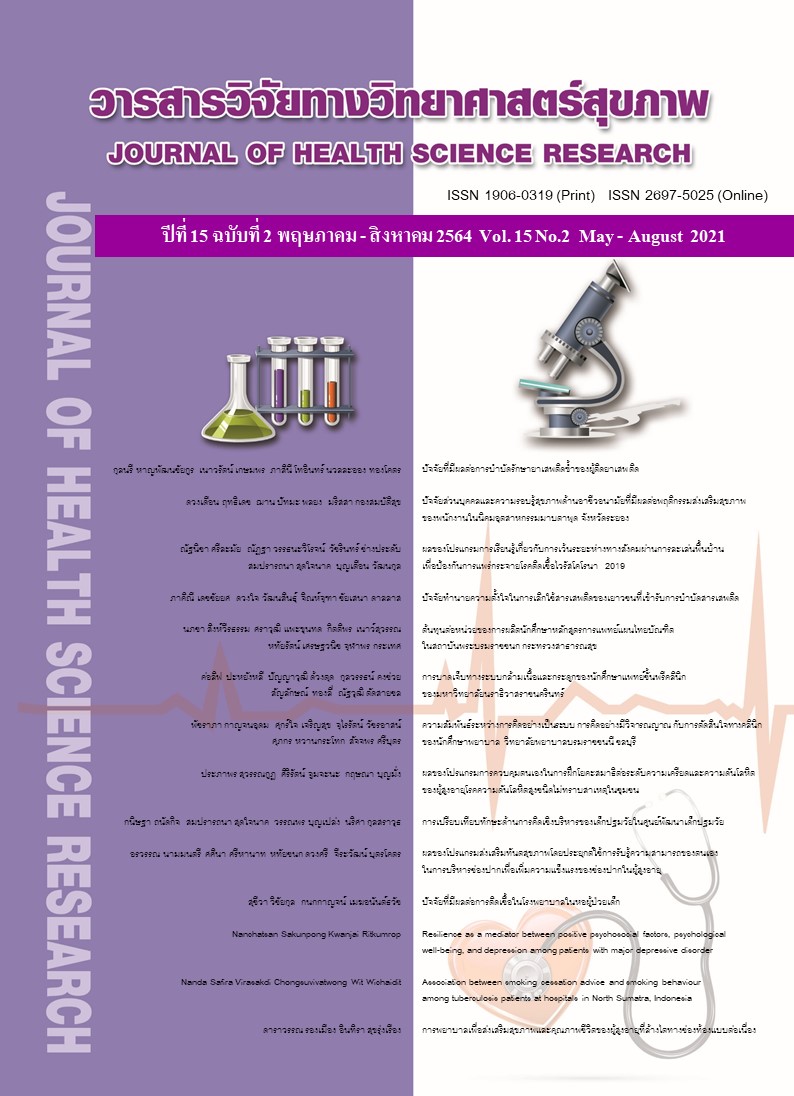การพยาบาลเพื่อส่งเสริมสุขภาพและคุณภาพชีวิตของผู้สูงอายุที่ล้างไต ทางช่องท้องแบบต่อเนื่อง
Main Article Content
บทคัดย่อ
บทคัดย่อ
โรคไตเรื้อรังมีอุบัติการณ์เพิ่มมากขึ้น โดยเฉพาะในผู้สูงอายุ หากการดำเนินของโรคเลวลงจะทำให้เข้าสู่โรคไตเรื้อรังระยะสุดท้ายต้องรับการรักษาด้วยการบำบัดทดแทนไต สำหรับประเทศไทยการล้างไตทางช่องท้องอย่างต่อเนื่อง เป็นรูปแบบการบำบัดทดแทนไตรูปแบบหนึ่งที่เลือกใช้ในผู้สูงอายุที่เป็นโรคไตเรื้อรังระยะสุดท้าย ข้อดีคือ ผู้สูงอายุ และผู้ดูแลสามารถทำได้เองที่บ้าน ประหยัดเวลา และค่าใช้จ่ายในการเดินทาง บทความวิชาการนี้ มีวัตถุประสงค์เพื่อนำเสนอ 1) สถานการณ์การล้างไตทางช่องท้องแบบต่อเนื่องในผู้สูงอายุ 2) กระบวนการสูงอายุและการล้างไตทางช่องท้องแบบต่อเนื่อง
3) รูปแบบการล้างไตทางช่องท้องแบบต่อเนื่อง 4) การประเมินสภาพผู้สูงอายุที่ล้างไตทางช่องท้องแบบต่อเนื่อง 5) การพยาบาลผู้สูงอายุที่ล้างไตทางช่องท้องแบบต่อเนื่อง และ 6) การพยาบาลเพื่อส่งเสริมสุขภาพและคุณภาพชีวิตของผู้สูงอายุที่ล้างไตทางช่องท้องแบบต่อเนื่อง สำหรับประเทศไทยการล้างไตทางช่องท้องมี 2 รูปแบบ ได้แก่ การล้างไตทางช่องท้องแบบต่อเนื่องด้วยตนเอง และการล้างไตทางช่องท้องโดยใช้เครื่องอัตโนมัติ การล้างไตทางช่องท้องอย่างต่อเนื่องในผู้สูงอายุมีข้อจำกัดหลายประการ อาจทำให้การล้างไตทางช่องท้องอย่างต่อเนื่องไม่มีประสิทธิภาพ พยาบาลเฉพาะทางด้านการดูแลผู้ป่วยล้างไตทางช่องท้องอย่างต่อเนื่อง จะต้องเป็นผู้ประเมินความพร้อมของผู้สูงอายุ โดยใช้แนวทางการประเมินภาวะสุขภาพผู้สูงอายุแบบองค์รวม และวางแผนช่วยเหลือให้ผู้สูงอายุ และผู้ดูแลสามารถปฏิบัติการล้างไตท่างช่องท้องอย่างต่อเนื่องได้อย่างมีประสิทธิภาพ ลดภาวะแทรกซ้อนที่อาจเกิดขึ้น
Downloads
Article Details
บทความที่ได้รับการตีพิมพ์เป็นลิขสิทธิ์ของวิทยาลัยพยาบาลบรมราชชนนี จังหวัดนนทบุรี
ข้อความที่ปรากฏในบทความแต่ละเรื่องในวารสารวิชาการเล่มนี้เป็นความคิดเห็นส่วนตัวของผู้เขียนแต่ละท่านไม่เกี่ยวข้องกับวิทยาลัยพยาบาลบรมราชชนนี จังหวัดนนทบุรี และคณาจารย์ท่านอื่น ในวิทยาลัยฯ แต่อย่างใด ความรับผิดชอบองค์ประกอบทั้งหมดของบทความแต่ละเรื่องเป็นของผู้เขียนแต่ละท่าน หากมีความผิดพลาดใด ๆ ผู้เขียนแต่ละท่านจะรับผิดชอบบทความของตนเองแต่ผู้เดียว
เอกสารอ้างอิง
Misra M. ESRD in the elderly: The scope of the problem. In Misra M, editor. Dialysis in older adults: Springer, New York; 2016. p.1-8. doi: 10.1007/978-1-4939-3320-4_1.
Lv JC, Zhang LX. Prevalence and disease burden of chronic kidney disease. In: Liu BC, Lan HY, Lv LL. editor. Renal Fibrosis: Mechanisms and Therapies. Advances in experimental medicine and biology, 2019;1165:3–15. doi: 10.1007/978-981-1 3-8871-2_1.
The Nephrology Society of Thailand. Thailand renal replacement therapy year 2015 [Internet]. 2015 [cited 2020 Dec 17]; Available from: https://www.nephrothai. org/wp-content/uploads/2020/08/Final_T RT_report_2015.pdf (in Thai).
Changsirikulchai S, Sriprach S, Thokanit NS, Janma J, Chuengsaman P, Sirivongs D. Survival analysis and associated factors in Thai patients on peritoneal dialysis under the PD first policy. Perit Dial Int. 2018; 38(3):172-8. doi: 10.3747/pdi.2017.00127.
So S, Stevenson J, Lee V. Kidney diseases in the elderly. In Nagaratnam N, Nagaratnam K, Cheuk G, editor. Advanced age geriatric care: a comprehensive guide. Switzerland: Springer. 2019:131-44. doi: 10.1007/978-3-319-96998-5_16.
National Health Security Office. National Health Security Office fund management manual, fiscal year 2019. Nonthaburi: Sahamit Printing Leasing & Leasing; 2018. (in Thai).
Setyapranata S, Holt SG. The gut in older patients on peritoneal dialysis. Perit Dial Int. 2015;35(6):650–4. doi: 10.3747/pdi.2014. 00341.
Li PK, Chow KM, Van de Luijtgaarden MW, Johnson DW, Jager KJ, Mehrotra R, Naicker S, Pecoits-Filho R, Yu XQ, Lameire N. Changes in the worldwide epidemiology of peritoneal dialysis. Nat Rev Nephrol. 2017;13(2):90–103. doi: 10.1038/nrneph.2016.181.
Wu H, Ye H, Huang R, Yi C, Wu J, Yu X, Yang X. Incidence and risk factors of peritoneal dialysis-related peritonitis in elderly patients: a retrospective clinical study. Perit Dial Int. 2020;40(1):26–33. doi: 10.1177/0896860819879868.
Griva K, Goh CS, Kang WCA, Yu ZL, Chan MC, Wu SY, Krishnasamy T, Foo M. Quality of life and emotional distress in patients and burden in caregivers: a comparison between assisted peritoneal dialysis and self-care peritoneal dialysis. Qual Life Res. 2016;25(2):373–84. doi: 10.1007/s 11136-015-1074-8.
Segall L, Nistor I, Van Biesen W, Brown EA, Heaf JG, Lindley E, Farrington K, Covic A. Dialysis modality choice in elderly patients with end-stage renal disease: a narrative review of the available evidence. Nephrol Dial Transplant. 2017;32(1):41-9. doi: 10.10 93/ndt/gfv411.
Franco MR, Bastos MG, Qureshi AR, Schreider A, Bastos KA, Divino-Filho JC, Fernandes NM. Incident elderly patients on peritoneal dialysis: epidemiological characteristics and modality impact on survival time. Saudi J Kidney Dis Transpl. 2017;28(4):782-91.
Goto NA, van Loon IN, Morpey MI, Verhaar MC, Willems HC, Emmelot-Vonk
MH, Bots ML, Boereboom FTJ, Hamaker ME. Geriatric assessment in elderly patients with end-stage kidney disease. Nephron. 2019;141(1):41–8. doi: 10.1159/0 00494222.
Brown EA, Farrington K. Geriatric assessment in advanced kidney disease. Clin J Am Soc Nephrol. 2019;14(7):1091–3. doi: 10.2215/CJN.14771218.
Van Loon IN, Wouters TR, Boereboom FT, Bots ML, Verhaar MC, Hamaker ME. The relevance of geriatric impairments in patients starting dialysis: a systematic review. Clin J Am Soc Nephrol. 2016;11 (7):1245–59. doi: 10.2215/CJN.06660615.
Zhang L, Hawley CM, Johnson DW. Focus on peritoneal dialysis training: working to decrease peritonitis rates. Nephrol Dial Transplant. 2016;31(2): 214–22. doi:10.1093/ndt/gfu403.
Musio F. Kidney disease and anemia in elderly patients. Clin Geriatr Med. 2019;35 (3):327–37. doi:10.1016/j.cger.2019.03.009.
Teerawattananon Y, Luz A, Pilasant S, Tangsathitkulchai S, Chootipongchaivat S, Tritasavit N, Yamabhai I, Tantivess S. How to meet the demand for good quality renal dialysis as part of universal health coverage in resource-limited settings? Health Res Policy Syst. 2016;14:21-8. doi: 10.1186/s12961-016-0090-7.
Giuliani A, Karopadi AN, Prieto-Velasco M, Manani SM, Crepaldi C, Ronco C. Worldwide experiences with assisted peritoneal dialysis. Perit Dial Int. 2017;37(5): 503–8. doi: 10.3747/pdi.2016.00214.
Oei E, Fan S. Peritoneal dialysis adequacy in elderly patients. Perit Dial Int 2015;35 (6):635–9. doi: 10.3747/pdi.2014.00336.
The Nephrology Society of Thailand. Clinical practice guideline (CPG) for peritoneal dialysis 2017. Bangkok: The Nephrology Society of Thailand; 2017. (in Thai).


